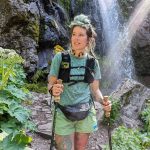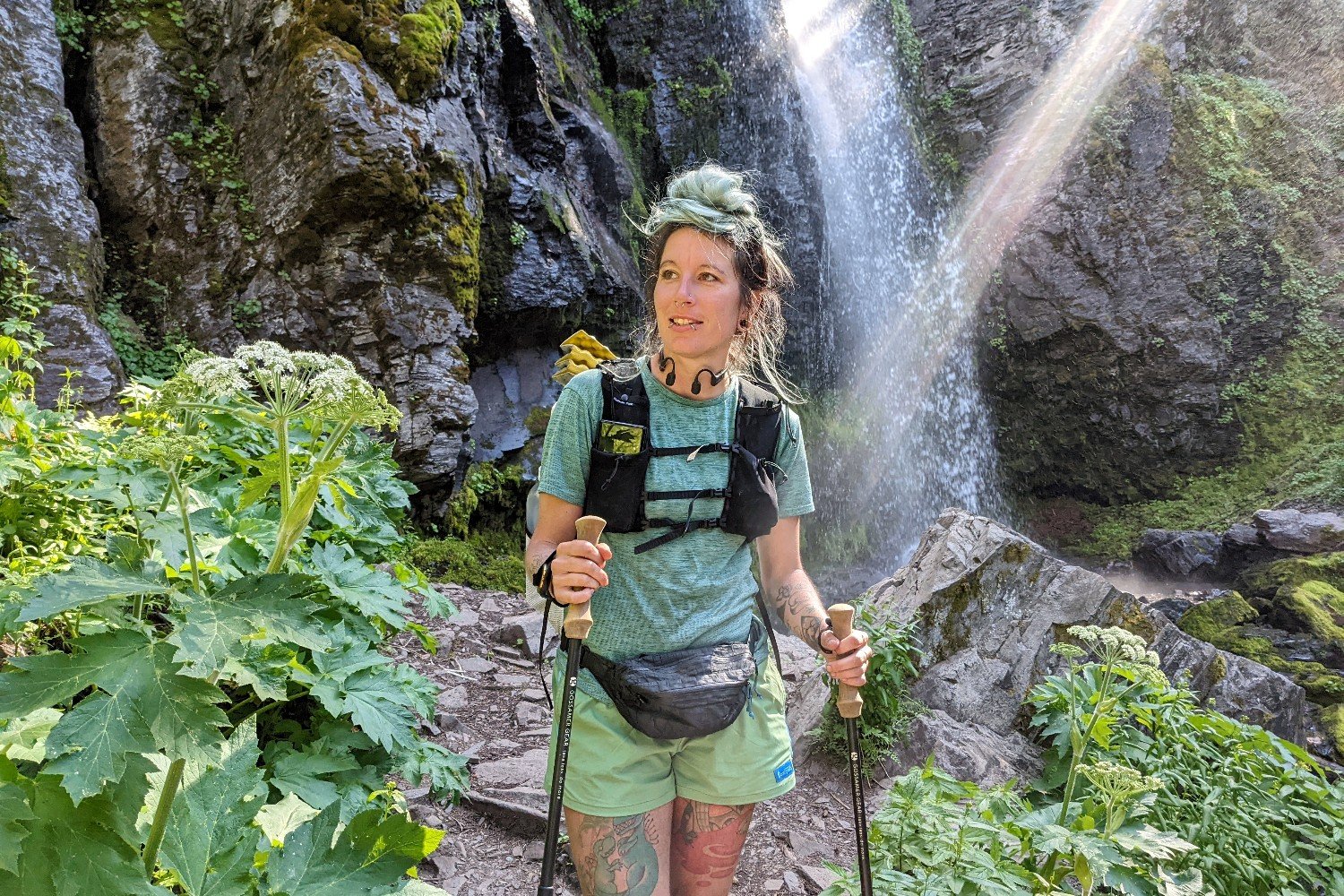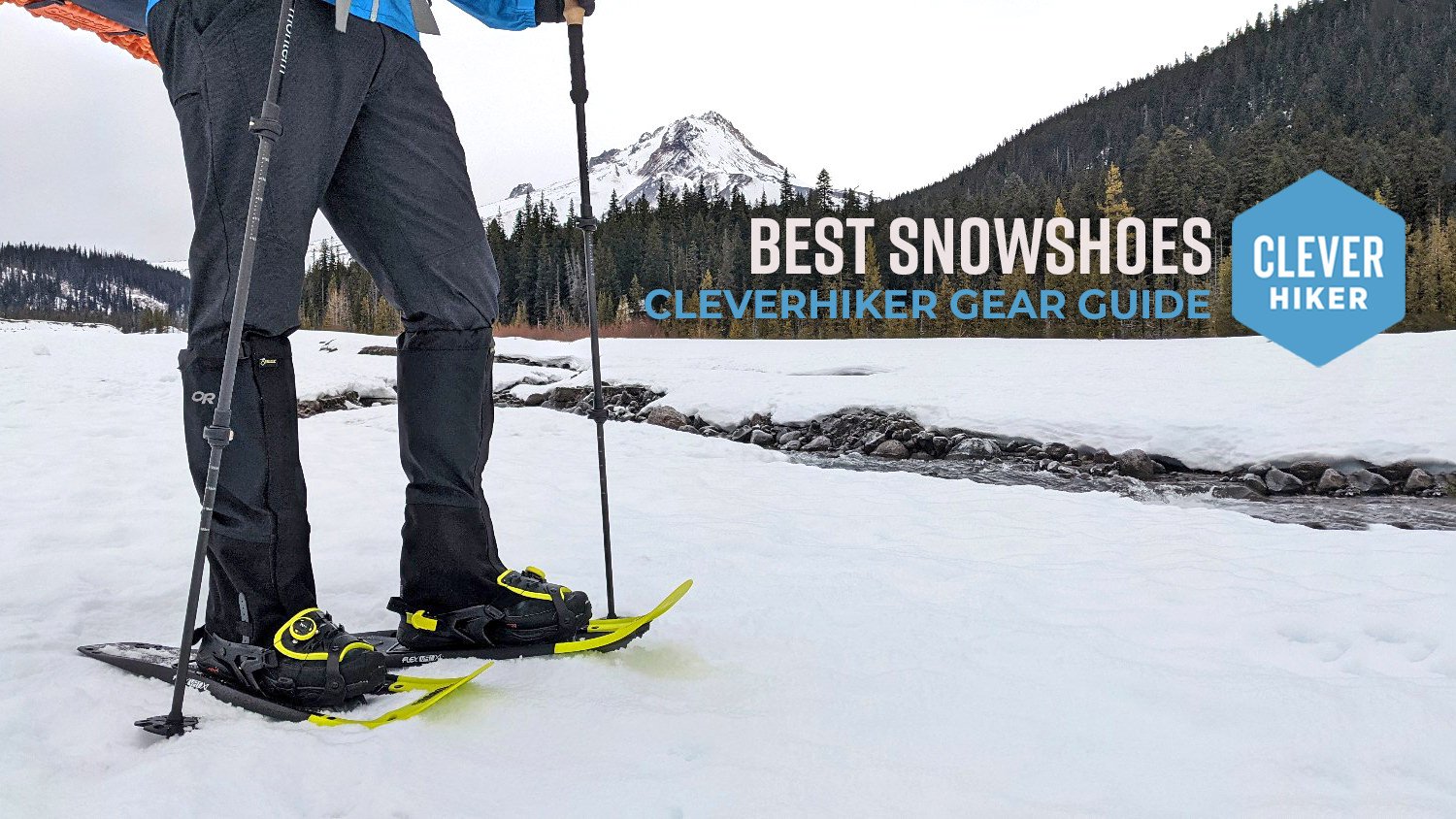
Snowshoeing is one of our all-time favorite winter activities. The trails are less crowded, the air is crisp, and there’s a certain silence you don’t experience during other seasons.
We’ve donned dozens of snowshoes and hit the winter trails, from ice-laden slopes to fresh powder-packed hills, to bring you this list of the best snowshoes on the market.
Last updated: September 29, 2023
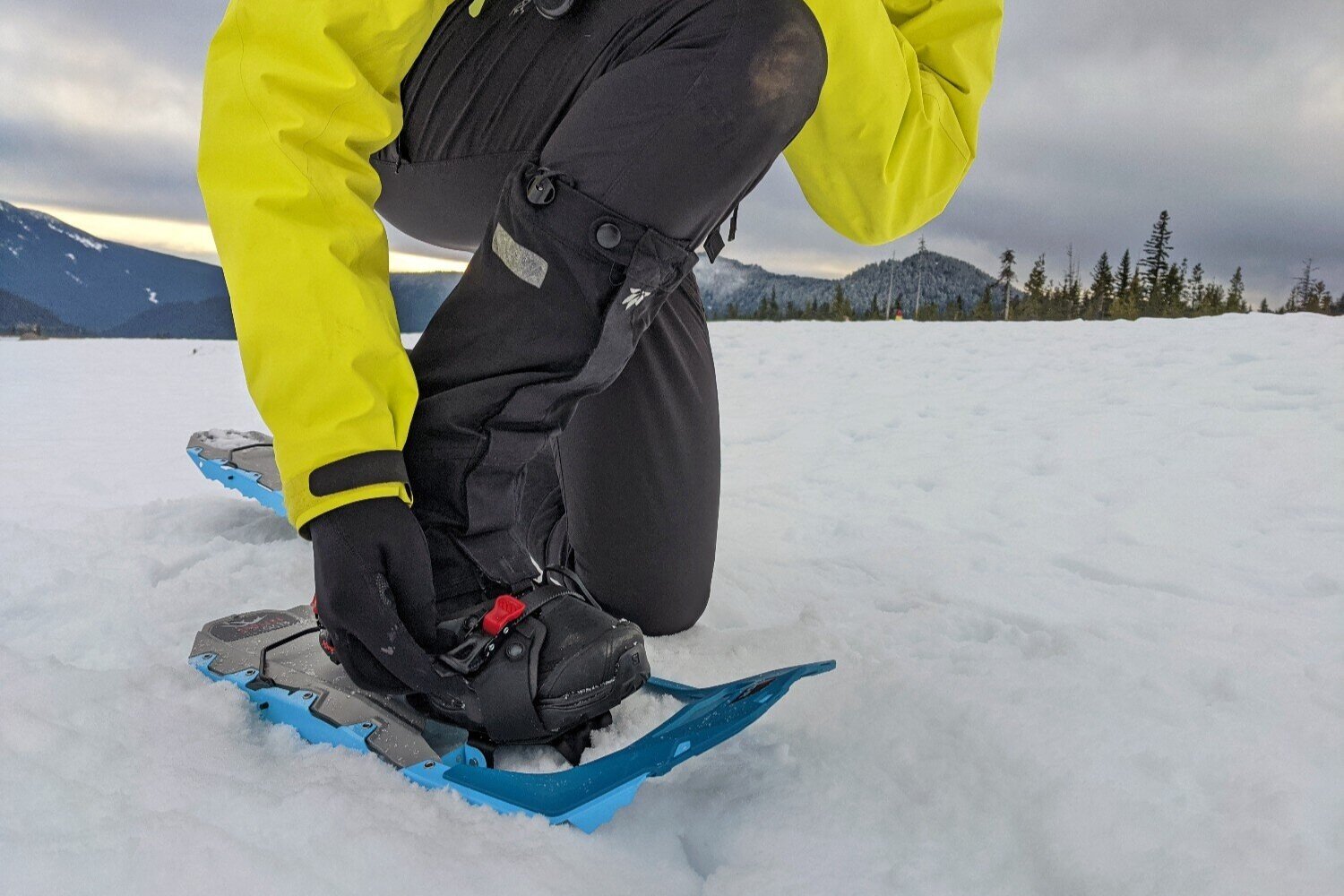
The bindings of the MSR Revo Explore are easy to adjust – even with gloves on
Quick Recommendations
Check out this quick list of our favorite snowshoes, or continue scrolling to see our full list with in-depth reviews.
- Best snowshoes overall for flotation, traction & comfort: MSR Lightning Ascent
- Best snowshoes for steep mountain terrain: Tubbs Flex VRT
- Best budget snowshoes: MSR Evo Trail
- Value-priced snowshoes for all experience levels & most types of terrain: Atlas Montane
- Best snowshoes for deep powder: Crescent Moon Gold 10
- Flexible snowshoes that allow for a natural gait: TSL Symbioz Hyperflex Elite
- Versatile snowshoes at a good value price: MSR Revo Explore
- Most affordable snowshoes: FLASHTEK Snowshoes
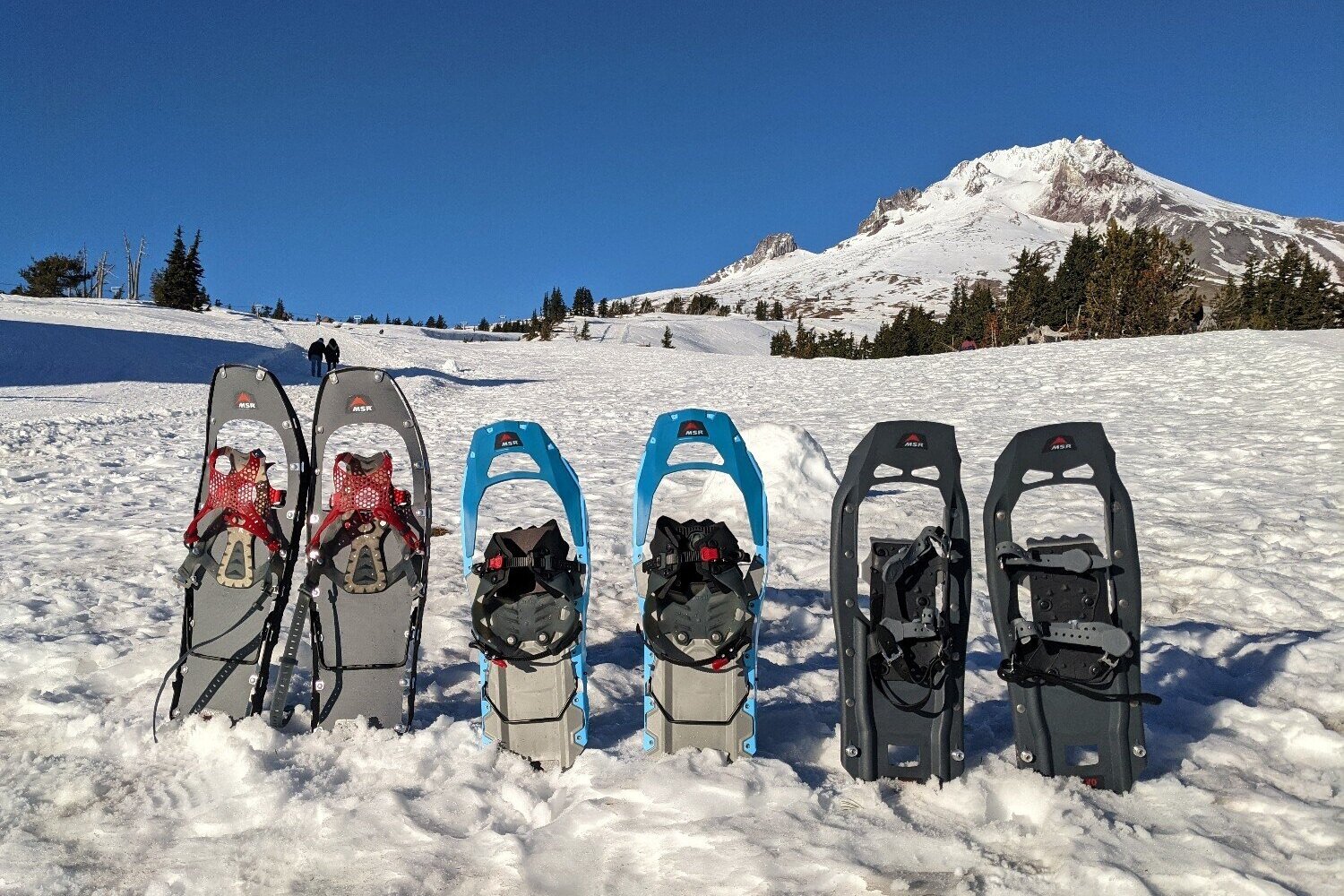
MSR MAKES SOME OF THE BEST & MOST APPROACHABLE SNOWSHOES. From left to right: MSR Lightning Ascent, MSR Revo Explore, MSR Evo Trail
What’s Most Important to You in a Pair of Snowshoes?
PRICE– You don’t have to spend a ton of money to get a good pair of snowshoes, but we’ve found that the flotation, weight, and comfort tend to be better if you spend a little more.
- Best value snowshoes:Tubbs Flex VRT, Atlas Montane & MSR Revo Explore
- Best budget snowshoes: MSR Evo Trail & FLASHTEK Snowshoes
- Best high-end snowshoes:MSR Lightning Ascent & TSL Symbioz Hyperflex Elite
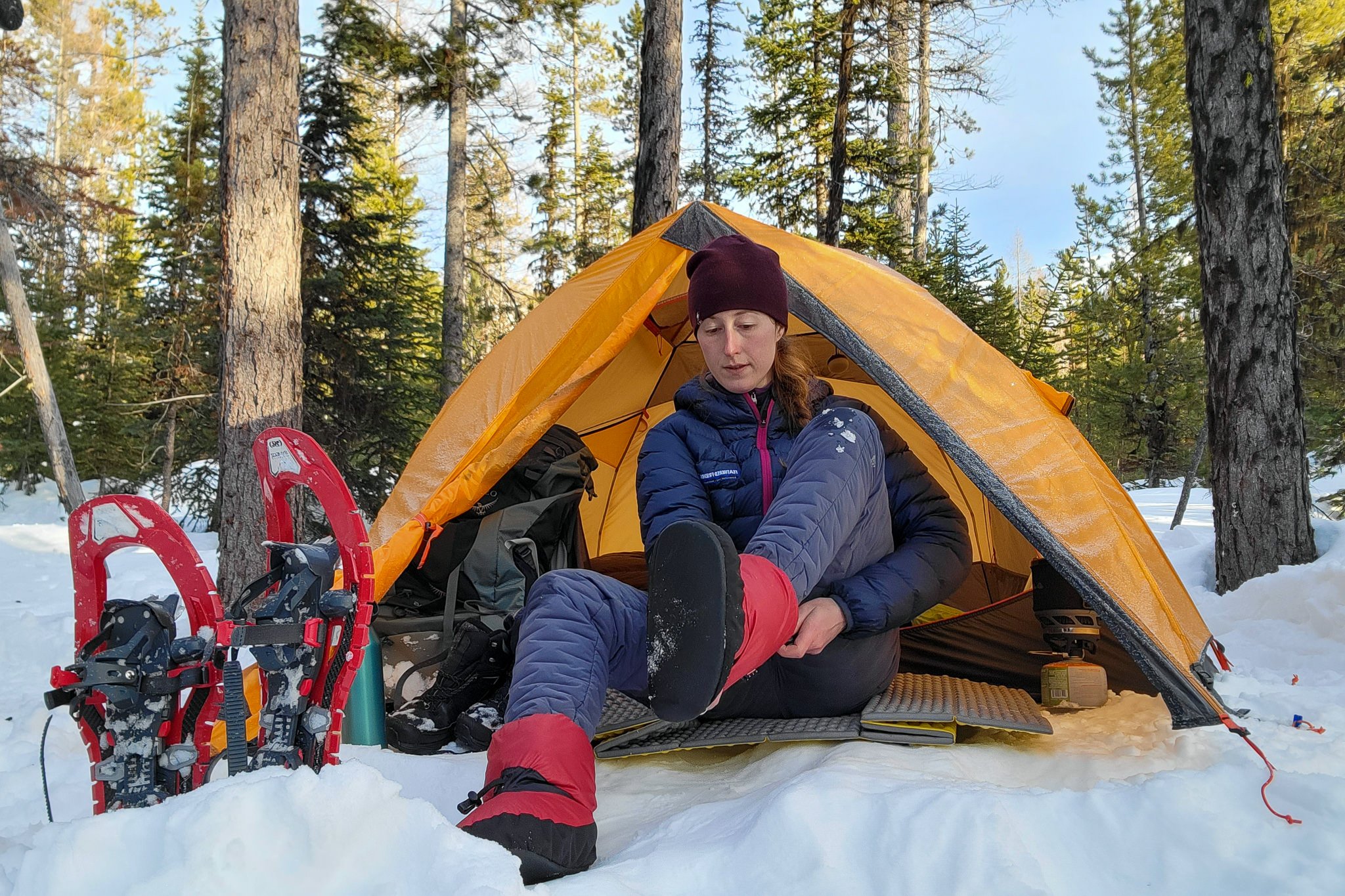
TSL’s Symbioz Hyperflex Elite are pricey, but they’re comfy, easy to adjust & allow for a natural gait
WEIGHT– Snowshoeing can be quite the workout, so keeping the weight of your snowshoes lower can save energy and help you go farther. That said, heavier snowshoes tend to be more durable because they’re typically made with metal parts instead of plastic.
- Best lightweight snowshoes: MSR Lightning Ascent, Tubbs Flex VRT & MSR Evo Trail
- Best heavy-duty snowshoes: Atlas Montane & Crescent Moon Gold 10
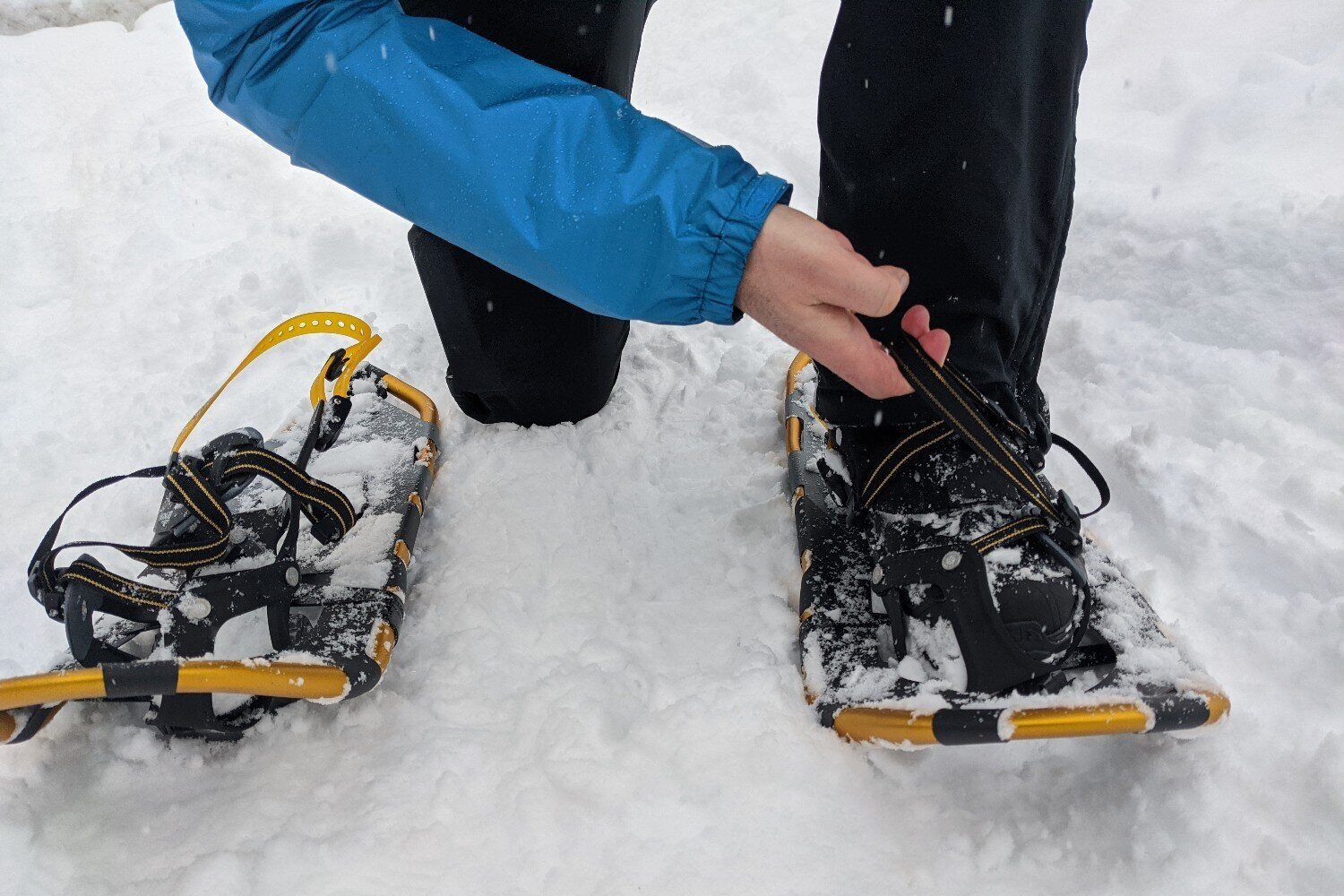
The single-pull lace bindings on the Atlas Montane Snowshoes are comfortable & easy to use
USE– Long, wide snowshoes work best for deep snow in the backcountry. If you mostly hike in mountainous terrain, you’ll want a pair of snowshoes with heel lifts to help with ascents. For groomed trails with mild terrain, a simple pair that’s flexible and affordable will work nicely.
- Best snowshoes for deep snow: Crescent Moon Gold 10
- Best snowshoes for mountain terrain: Tubbs Flex VRT, MSR Lightning Ascent & TSL Symbioz Hyperflex Elite
- Best snowshoes for rolling terrain: MSR Evo Trail& MSR Revo Explore
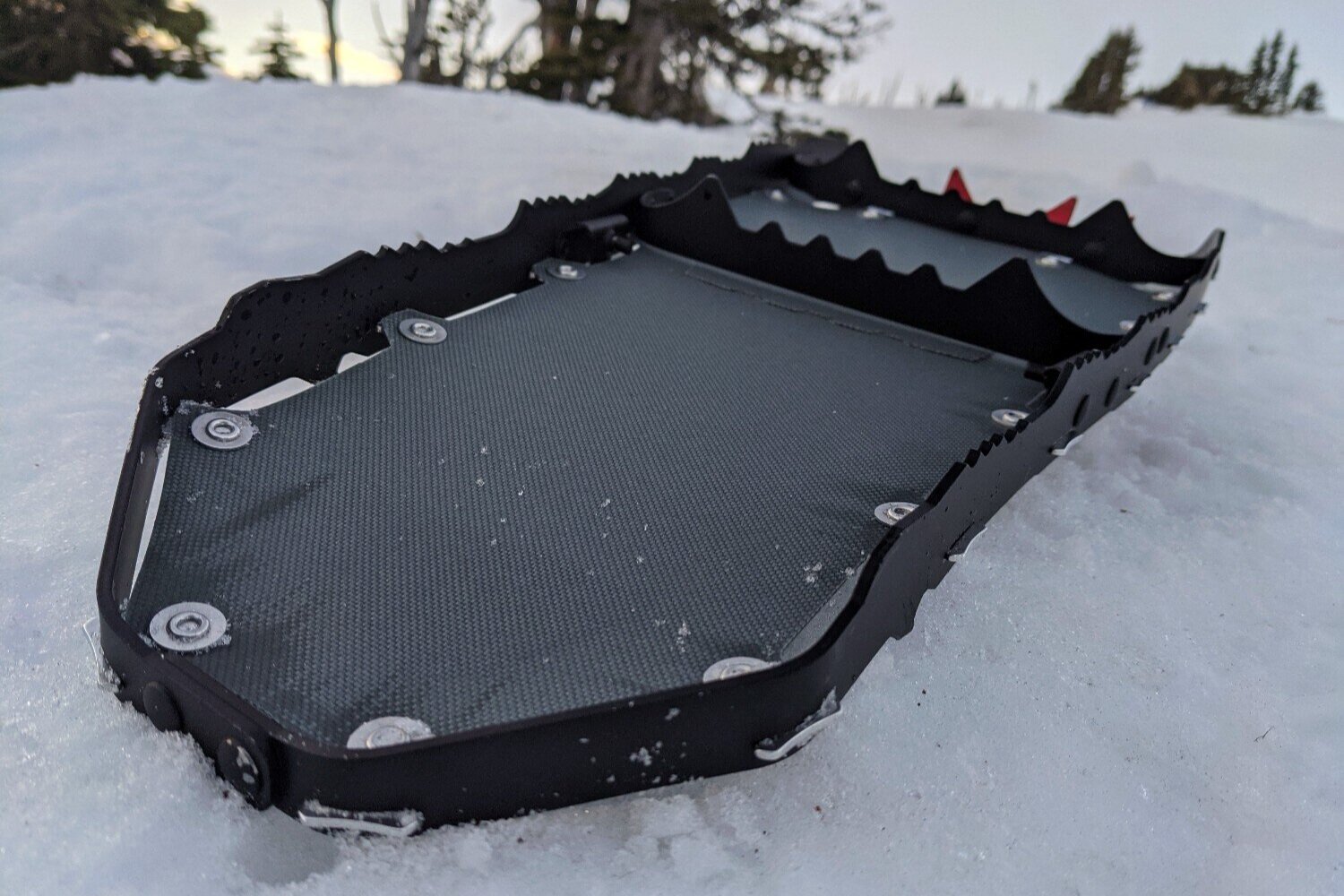
The traction on the MSR Lightning Ascent snowshoes works well in most types of terrain
Best Snowshoes for Mountaineering of 2023
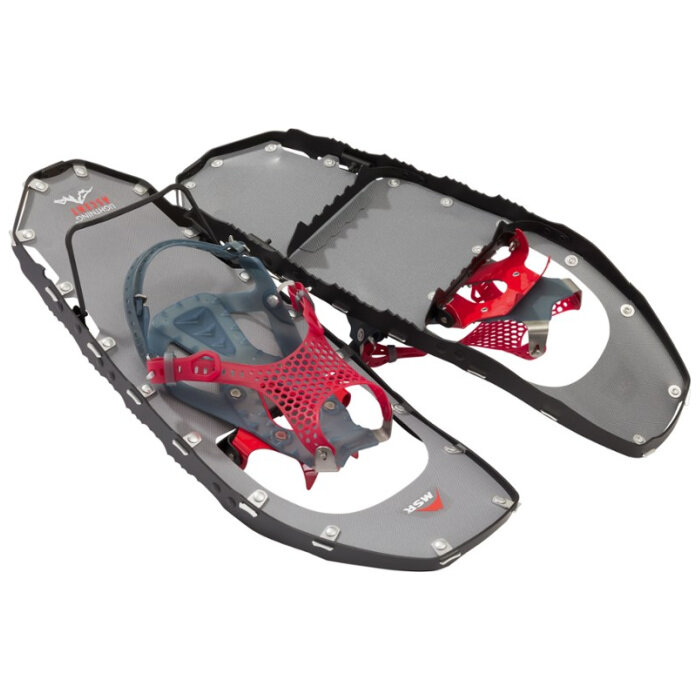
BEST SNOWSHOES OVERALL FOR FLOTATION, TRACTION & COMFORT
MSRP: $390
WEIGHT (PAIR – 25 in.): 4 lbs. 5 oz.
LENGTH: 22”, 25”, or 30”; optional 5” tails
BEST USE: All-around, excels on mountain terrain
PROS: Good traction, option to lengthen with tails, good flotation, lightweight, comfy & secure bindings, heel lifts
CONS: Expensive
BOTTOM LINE: MSR’s Lightning Ascent snowshoes (view women’s here) are a great all-around choice for both beginners and seasoned snowshoers. These lightweight snowshoes are designed with a ton of quality features, like heel lifts that make traversing uphill a breeze, aggressive toe crampons to ensure solid footing as you ascend, and bindings that are comfortable and secure. One of our favorite things about MSR snowshoes is that they give the option to add flotation tails (sold separately), so you can adapt the length of your snowshoes to the terrain and conditions. The Lightning Ascents are the most expensive snowshoes on our list, but they provide the best all-around performance with their excellent balance of traction, flotation, and comfort.
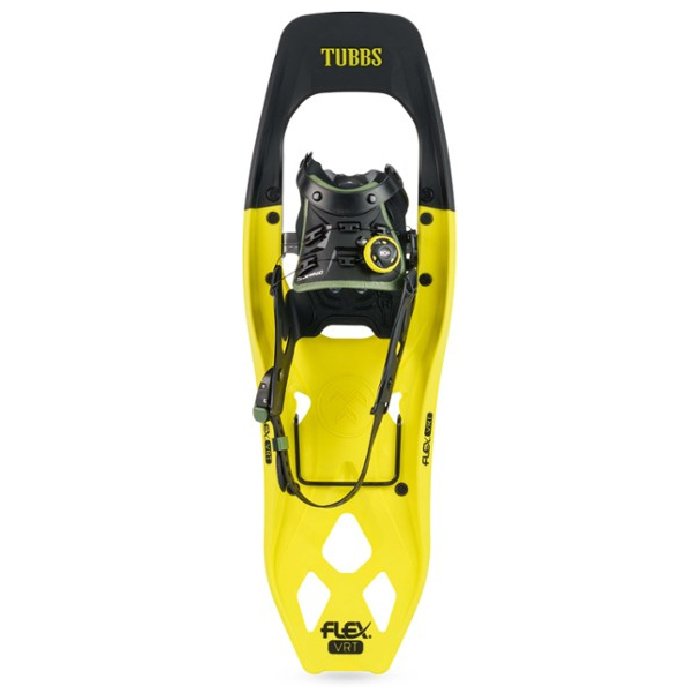
BEST SNOWSHOES FOR STEEP MOUNTAIN TERRAIN
MSRP: $280
WEIGHT (PAIR – 25 in.): 4 lbs. 5.9 oz.
LENGTH: 25” or 29”
BEST USE: All-around, excels on steep mountain terrain
PROS: Aggressive traction, easy to adjust & comfortable Boa binding, lightweight, heel lifts, durable
CONS: Flotation isn’t as good in deep powder
BOTTOM LINE: With aggressive front crampons, deep-toothed traction rails, and heel lifts, the Tubbs Flex VRT (view women’s here) are an excellent choice for those who like to adventure in steep, mountainous terrain. The Boa closure system only requires a couple turns of a dial to provide a comfortable and secure fit, making the Flex VRT one of the easiest snowshoes to adjust out of any we’ve ever tested. The narrow width cuts weight and helps you maintain a natural gait, but it makes a small impact on flotation in really powdery snow. We recommend the Flex VRT for snowshoers who need maximum traction to tackle steep ascents when the snow hits.
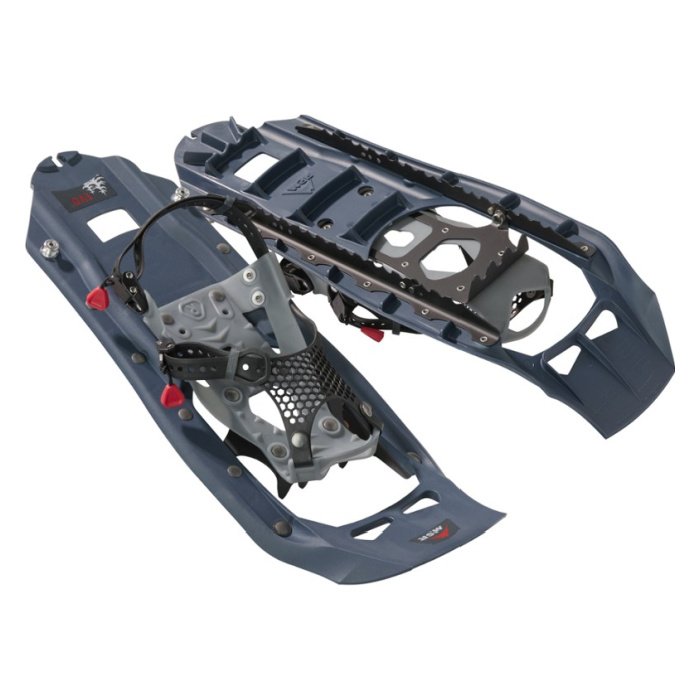
BEST BUDGET SNOWSHOES
MSRP: $170
WEIGHT (PAIR): 3 lbs. 10 oz.
LENGTH: 22”; optional 6” tails
BEST USE: Rolling terrain
PROS: Affordable, option to lengthen with tails, can accommodate large shoes sizes (up to men’s 15), lightweight
CONS: Bindings aren’t as comfortable or secure as some
BOTTOM LINE: The MSR Evo Trails drop all the fancy extras, like heel lifts and sophisticated bindings, in favor of simplicity and good flotation at an affordable price. The wide, consistent shape is good for keeping you above the snow in most conditions, and MSR gives the option to add tails for extra flotation if you’ll be hiking in deep powder. The Evos work best for easy-to-moderate hikes on rolling terrain, but they’re not the best choice for steep traverses since they don’t have heel lifts to help you ascend. Whether you’re looking for something simple, or you’re a beginner who’s just getting started with snowshoeing, the Evo Trails are a great quality option for the price.
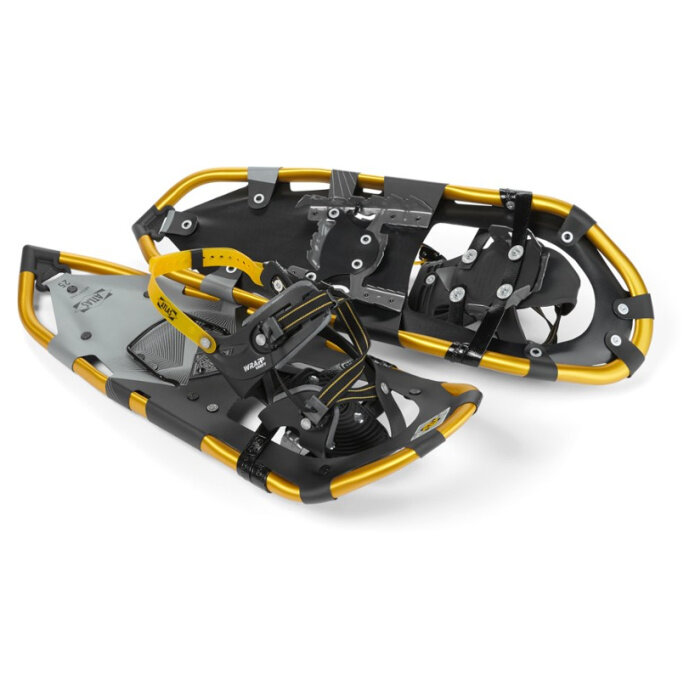
VALUE-PRICED SNOWSHOE FOR ALL EXPERIENCE LEVELS & MOST TYPES OF TERRAIN
MSRP: $250
WEIGHT (PAIR – 30 in.): 4 lbs. 4 oz.
LENGTH: 25”, 30”, or 35”
BEST USE: All-around
PROS: Good value, comfy binding, good traction on ice, heel lifts
CONS: Flotation isn’t as good as others of the same length, binding straps can freeze & become difficult to adjust
BOTTOM LINE: With their teardrop shape and classic bindings, the Atlas Montanes (view women’s here) feature a tried-and-true design that will appeal to a wide range of hikers. The nylon strap bindings are comfortable and do a great job of minimizing pressure points that can lead to cold and sore feet. The tapered shape makes these snowshoes weigh less than you would expect for being so long, but it also means less surface area for flotation in the really powdery stuff. Overall we think the Atlas Montanes are a great value option that are comfortable and work well in most conditions.
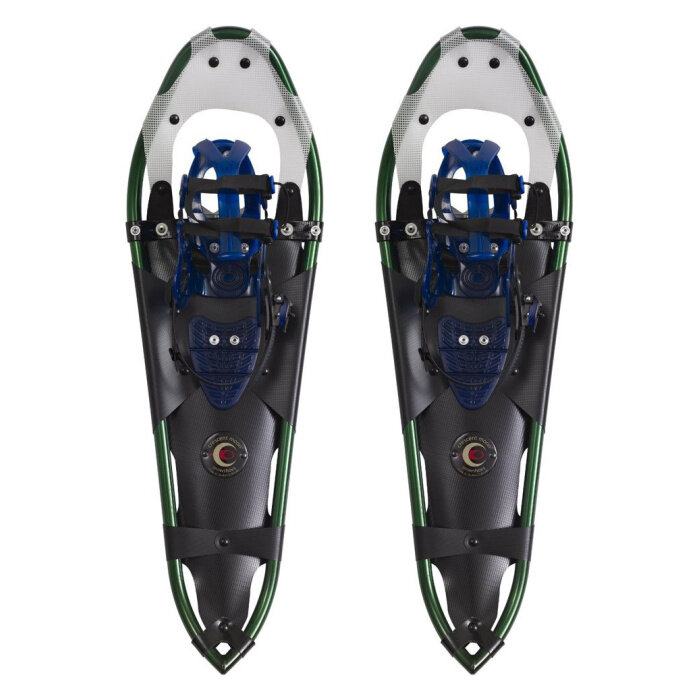
BEST SNOWSHOES FOR DEEP POWDER
MSRP: $240
WEIGHT (PAIR): 4 lbs. 15.2 oz.
LENGTH: 32”
BEST USE: Deep snow
PROS: Excellent flotation, easy-stride shape, can accommodate large shoes sizes (up to men’s 15)
CONS: Heel lift design isn’t as convenient as others, a bit heavy
BOTTOM LINE: The Crescent Moon Gold 10 snowshoes have the largest surface area of all the snowshoes on our list, making them the best for deep powder conditions. While the Gold 10s are the heaviest and widest snowshoes we tested, we found the stride ergonomics to be pretty good thanks to the teardrop shape. The one minor complaint we have with these snowshoes is that the heel lift snaps on and off instead of pivoting up and down. So you would need to store them in a pocket when they’re not in use, then physically snap them back on when you want to use them. That’s not a dealbreaker though, and we still highly recommend the Gold 10s for those who snowshoe in rolling terrain areas that are consistently subjected to heavy dumps of fresh powder.
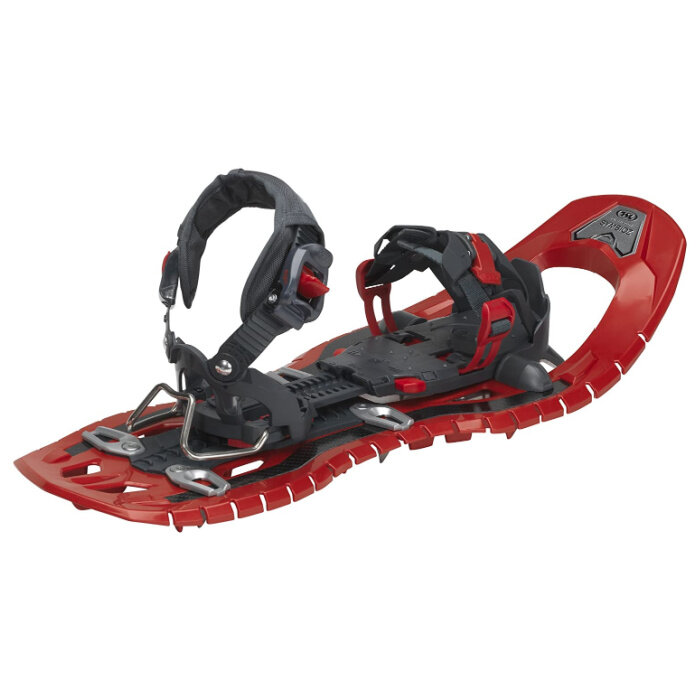
FLEXIBLE SNOWSHOES THAT ALLOW FOR A NATURAL STRIDE
MSRP: $290
WEIGHT (PAIR – 23.5 in.): 4 lbs. 4.8 oz.
LENGTH: 20.5”, 23.5”, or 27”
BEST USE: Mountain terrain
PROS: Easy-stride shape, flexible frame, comfy & secure binding, heel lifts, good traction, can accommodate large shoes sizes (up to men’s 15), comes with carry bag
CONS: Flotation isn’t as good as some, expensive
BOTTOM LINE: The TSL Symbioz Hyperflex Elites are the most flexible snowshoes on our list and they have exceptionally comfy bindings that “remember” your shoe size. The unique shape of the decking allows for a more natural stride, making them more comfortable to walk in than many others. But because the frame is tapered, the flotation isn’t as good in powdery snow as snowshoes that are consistently wide through the whole length. We recommend the Hyperflex for snowshoers who like to move fast over packed mountain terrain.
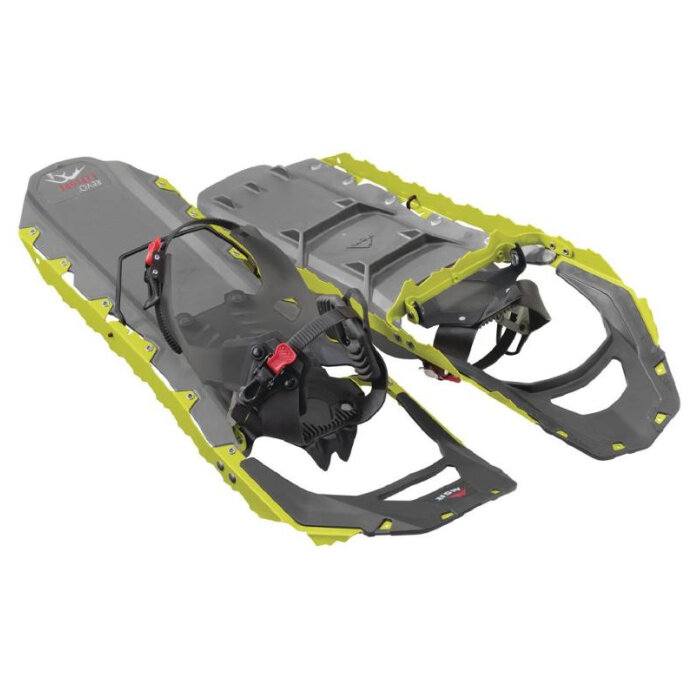
VERSATILE SNOWSHOES AT A VALUE PRICE
MSRP: $270
WEIGHT (PAIR – 22 in.): 4 lbs.
LENGTH: 22” or 25”; optional 5” tails
BEST USE: Rolling terrain
PROS: Option to lengthen with tails, shape helps maintain a natural gait, heel lifts
CONS: Bindings aren’t as comfortable as some
BOTTOM LINE: MSR’s Revo Explore snowshoes (view women’s here) are an excellent value option since they have most of the features of more expensive snowshoes (like heel lifts and toothed side rails) at a more accessible price. They have less surface area than many of the other snowshoes on our list which makes them pretty lightweight, but this also has an impact on flotation. We recommend buying the optional flotation tails if you’ll be snowshoeing in deep snow. The Revo Explores are a good in-between option if you like the features of our top pick, the MSR Lightning Ascent, but don’t mind switching to a plastic decking and a slight downgrade from steel crampons to save some money.
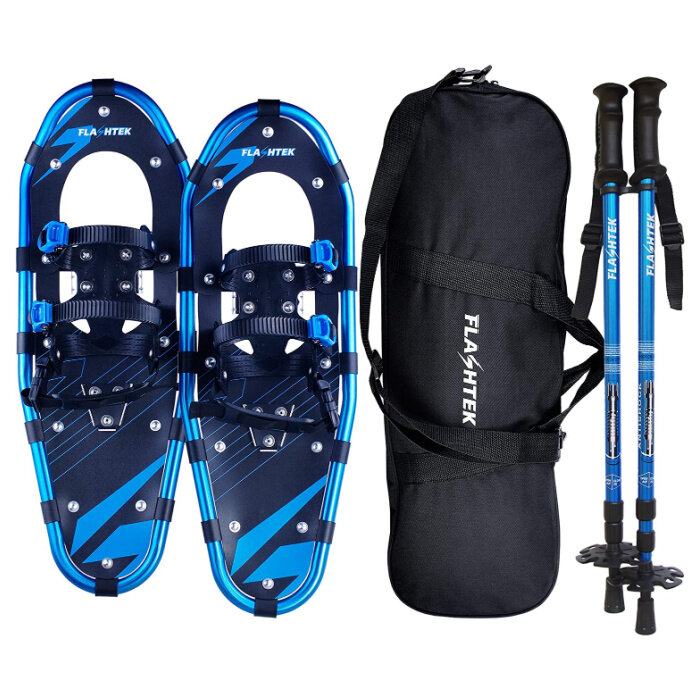
MOST AFFORDABLE SNOWSHOES
MSRP: $54-70 (depends on size)
WEIGHT (PAIR – 25 in.): 3 lbs. 11.2 oz.
LENGTH: 21”, 25”, 30”
BEST USE: Groomed trails and light powder
PROS: Very affordable, comes with trekking poles & carry bag
CONS: Not as durable as others, traction isn’t as good as others, flotation isn’t as good as others
BOTTOM LINE: The price of the FLASHTEK Snowshoes really can’t be beat, especially since they come with a carry bag and trekking poles. The traction and flotation of these snowshoes aren’t on par with the others on our list, but they’re good for first-time snowshoers who want to try the sport before making a big money commitment.
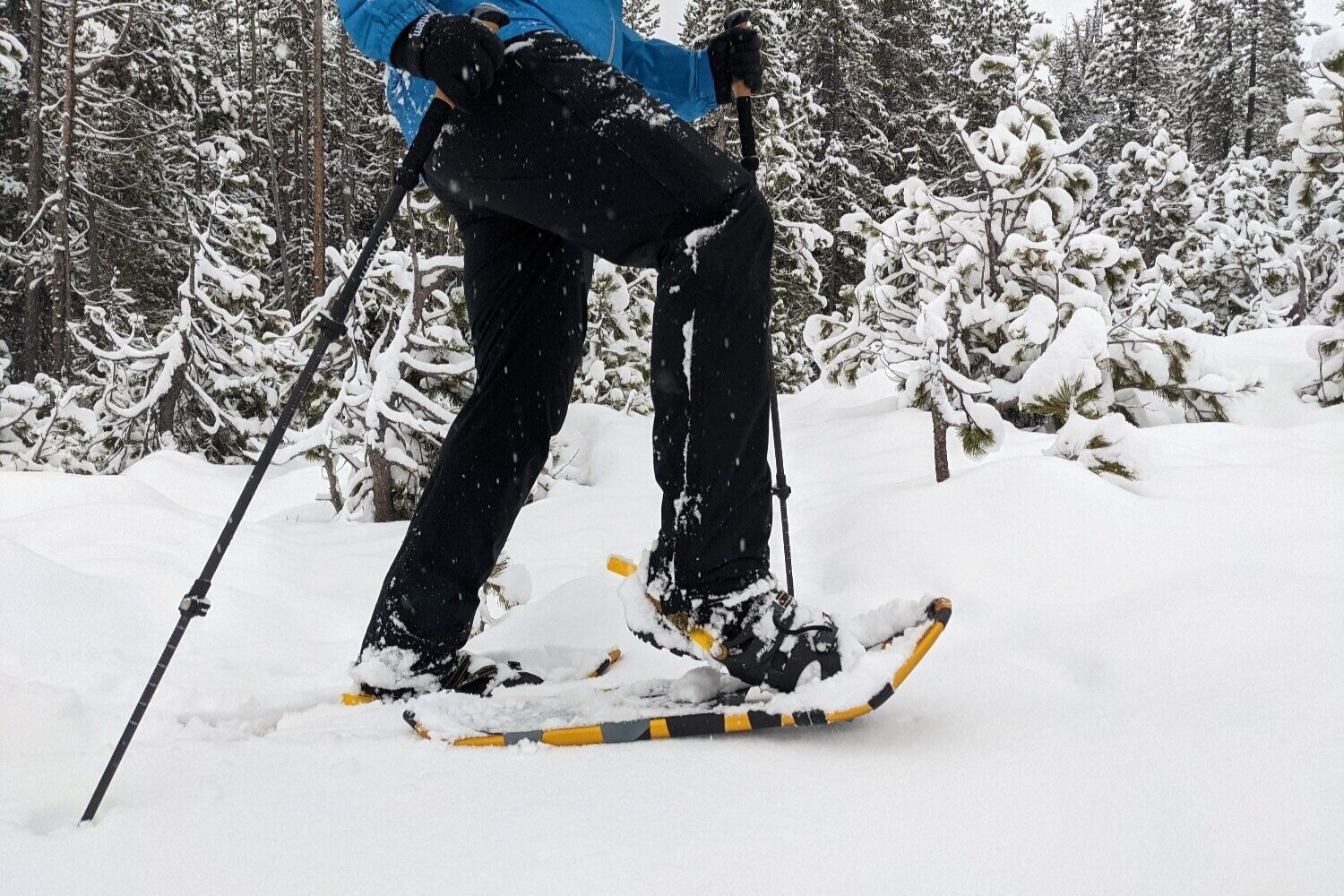
The shape of the Atlas Montane Snowshoes makes them lightweight & easy to walk in
CRITICAL SNOWSHOE CONSIDERATIONS
FOOTWEAR – The footwear you choose will have a big effect on your overall comfort while snowshoeing. We tend to go for lightweight boots that are waterproof and lightly insulated so that we’re protected but not overheating while hiking. Check out our Best Winter Boots for Men and Women and our Best Hiking Boots for Men and Women lists to find the perfect pair for you.
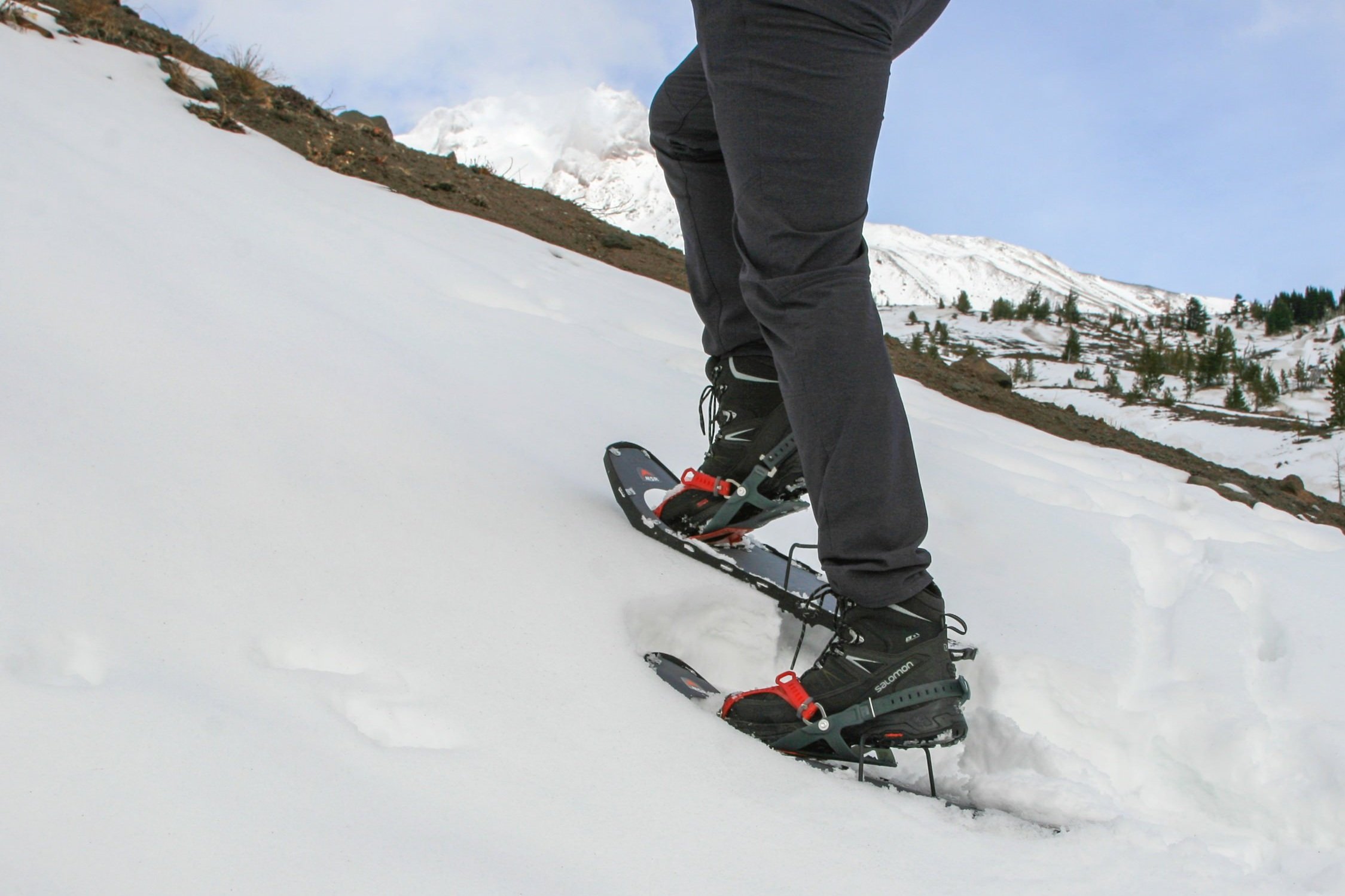
LENGTH/WIDTH – The longer and wider your snowshoes, the easier it is to stay on top of the snow.But it can also be harder to walk naturally in snowshoes that are wider or longer than necessary. We tend to prefer snowshoes that are around 25 inches long with a tapered shape to get the best balance of flotation and ease of use. MSR gives you the option to add Flotation Tails to their snowshoes, which allows you to easily adapt the length to the snow pack.
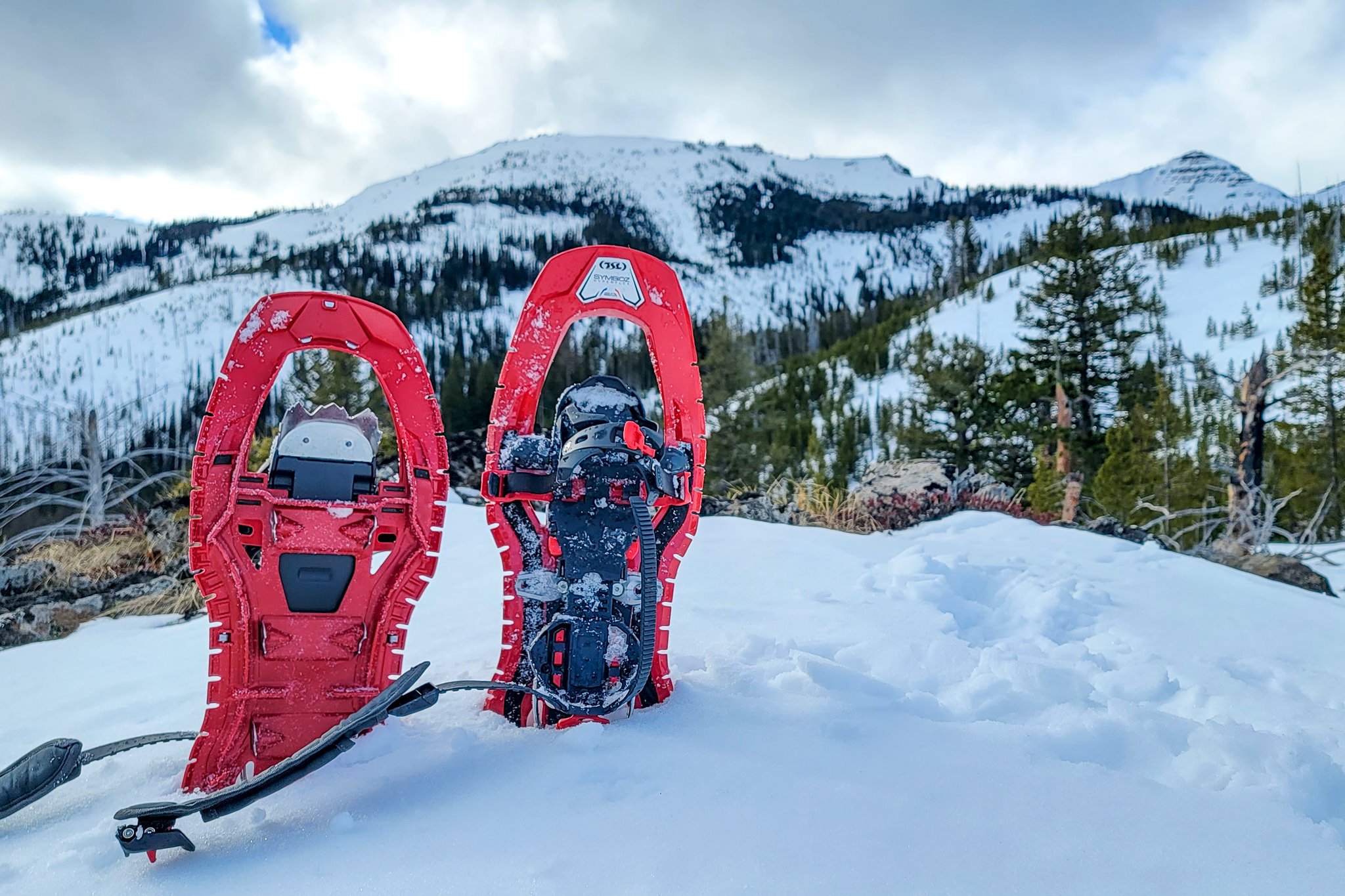
The shape of the TSL Symbioz Hyperflex Elite make them easy to walk in
TRACTION – The style of crampons and decking on a pair of snowshoes will help you determine what conditions they’re best for. Toe crampons are what give you most of your traction on icy and hard-packed snow; deep, steel toe crampons are the best for really icy conditions. Side rails, or traction bars, are featured on most snowshoes and help with lateral traction tol keep you stable as you traverse across a slope. Snowshoes with crampons and siderail teeth that go in multiple directions will provide the best traction on steep inclines.
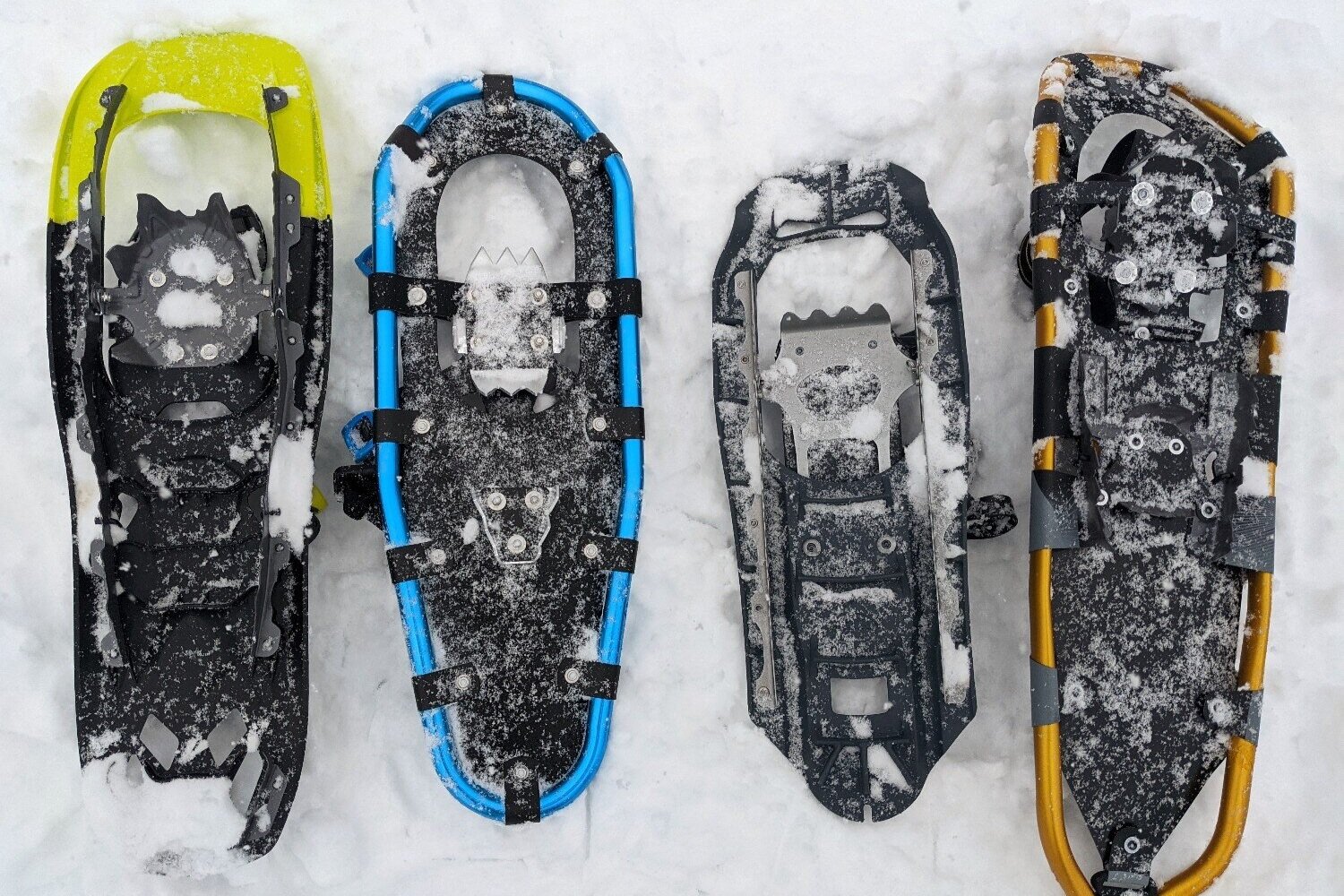
Comparing crampons on some of the best snowshoes. From left to right: Tubbs Flex VRT, FLASHTEK Snowshoes , MSR Evo Trail & Atlas Montane
TREKKING POLES – Trekking poles aren’t a necessary item, but they help a lot with momentum, circulation, and stability while snowshoeing. We use trekking poles for most of our winter adventures – check out our Best Trekking Poles list to see our top recommendations.
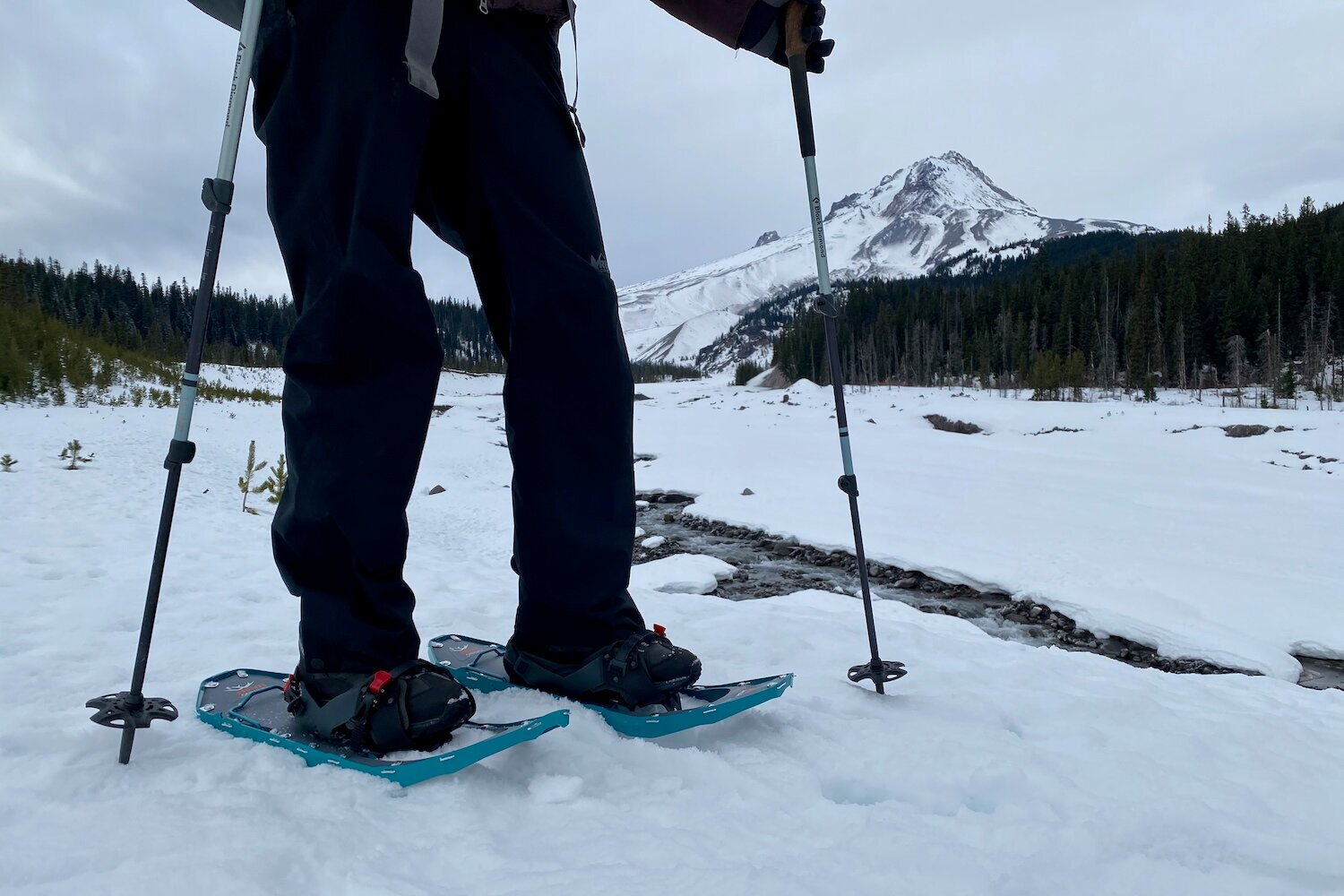
We almost always use trekking poles for snowshoe treks for added stability & increased momentum
GAITERS – Gaiters help keep snow and ice from building up in your boots. Snowshoeing can be hard on gear, so we recommend going with a high-quality pair of durable and waterproof gaiters. Our favorites are REI Backpacker Gaiters and the Crocodile Gaiters from Outdoor Research. If you’re on a tight budget, some rain pants can function as both an insulating layer to stave off wind and wet and a way to keep snow out of your shoes. Some rain pants also feature a boot hook that clips to your laces to keep the wet stuff out.
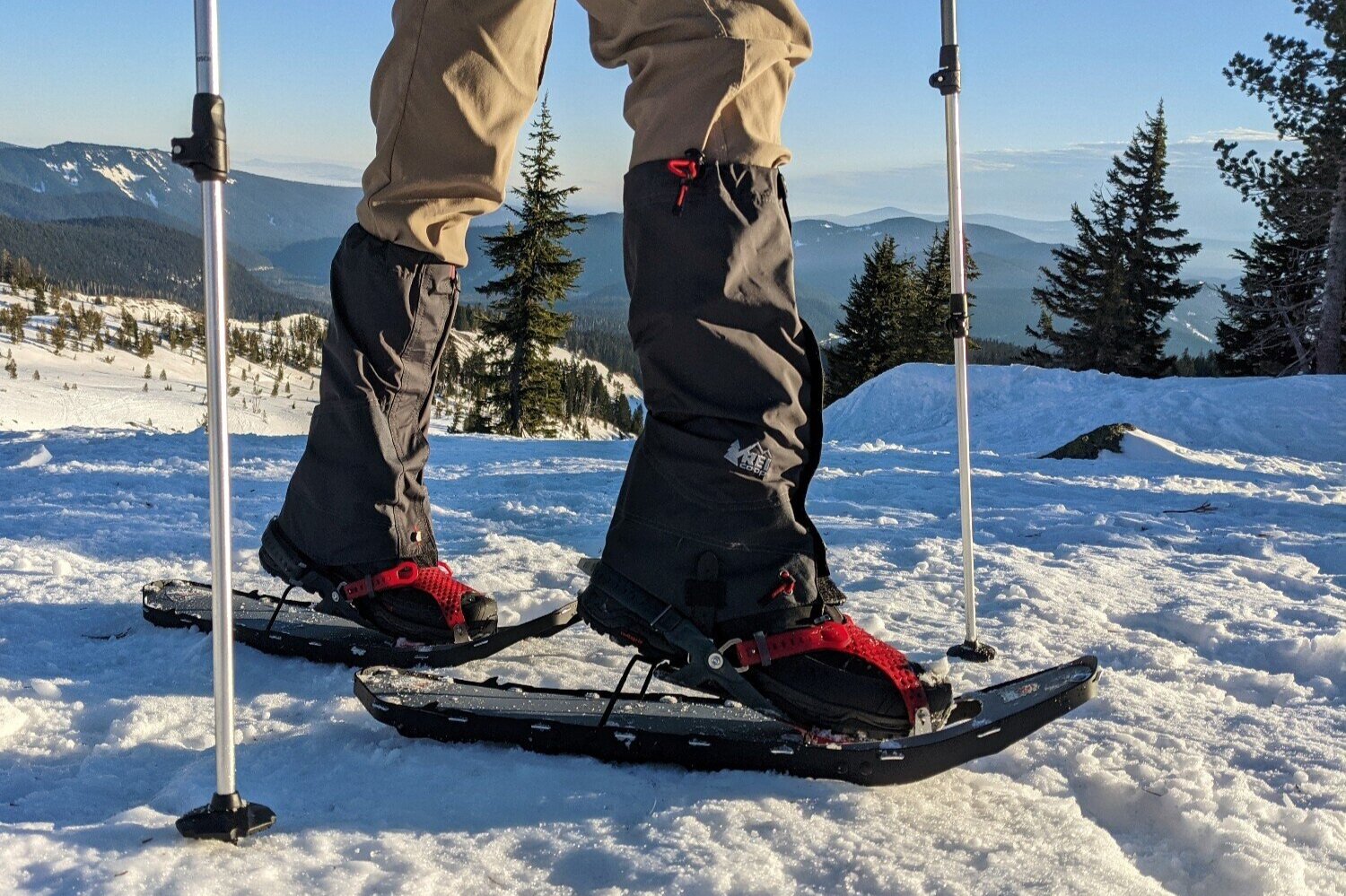
Using gaiters, like the REI Backpacker Gaiters, keeps snow & ice out of your shoes
Need More Gear Advice?
If you liked this list, you’ll love the CleverHiker Gear Guide where we test and recommend tons of outdoor adventure gear from a variety of categories. here are some links to popular articles:
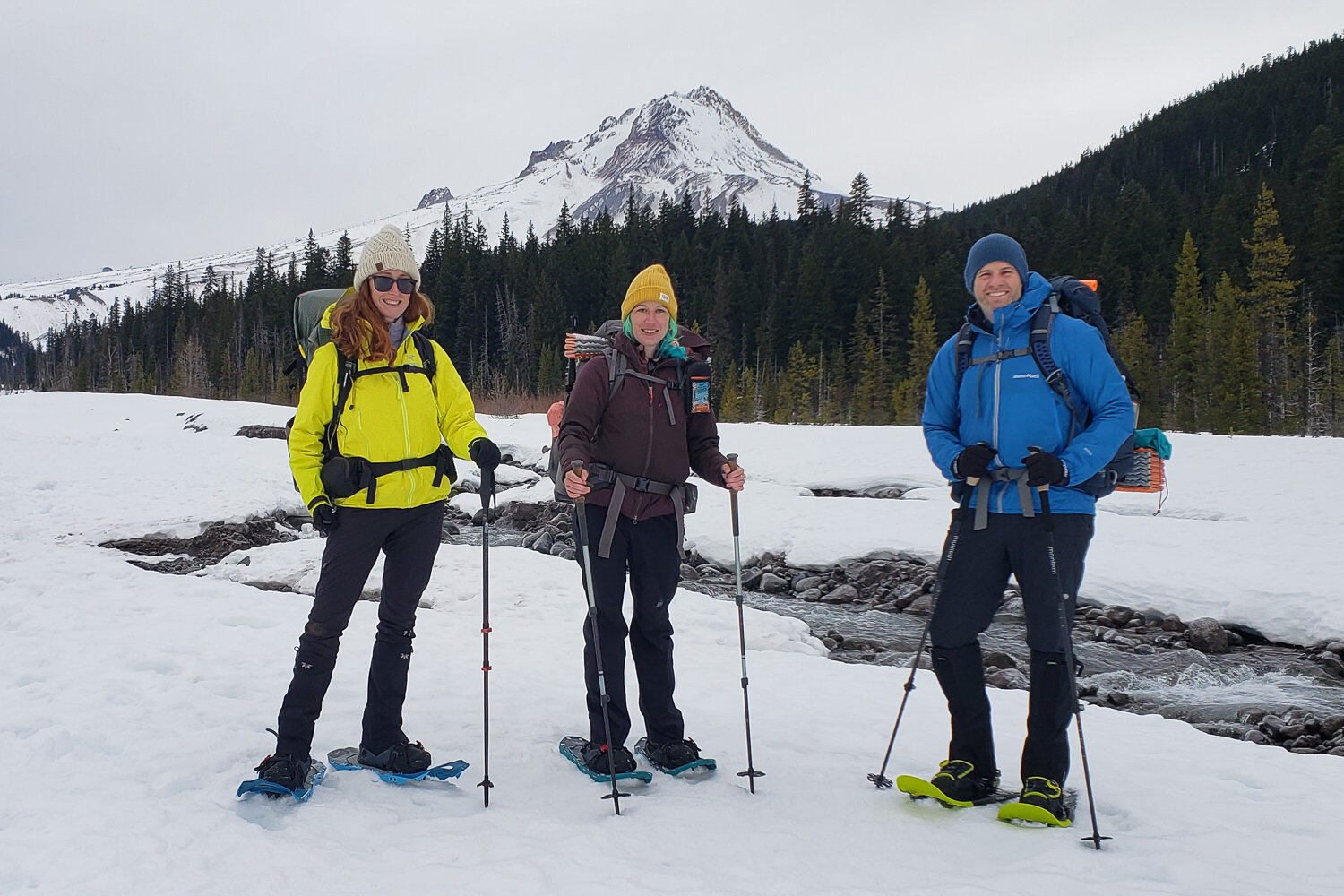
We own & use all of the snowshoes we recommend
Why Trust Us?
We fully understand how tough it is to find trustworthy gear advice, and that’s one of the main reasons we built CleverHiker. We live for outdoor adventure, and we take these guides very seriously. Here are some of the reasons you can trust us:
- Our choices are completely independent and based on personal experience.
- We’ve logged over 10,000 trail miles and test outdoor gear for a living.
- We own and field test every product we recommend, which is sadly not the norm.
- We travel to industry trade shows to learn about upcoming product innovations.
- We constantly update our guides when new products launch.
- We treat our recommendations as if they were for our family and friends.
- We’re lifelong learners and we’re always open to constructive criticism. If you think we’ve missed a product or got something wrong, we’d love to hear your feedback.
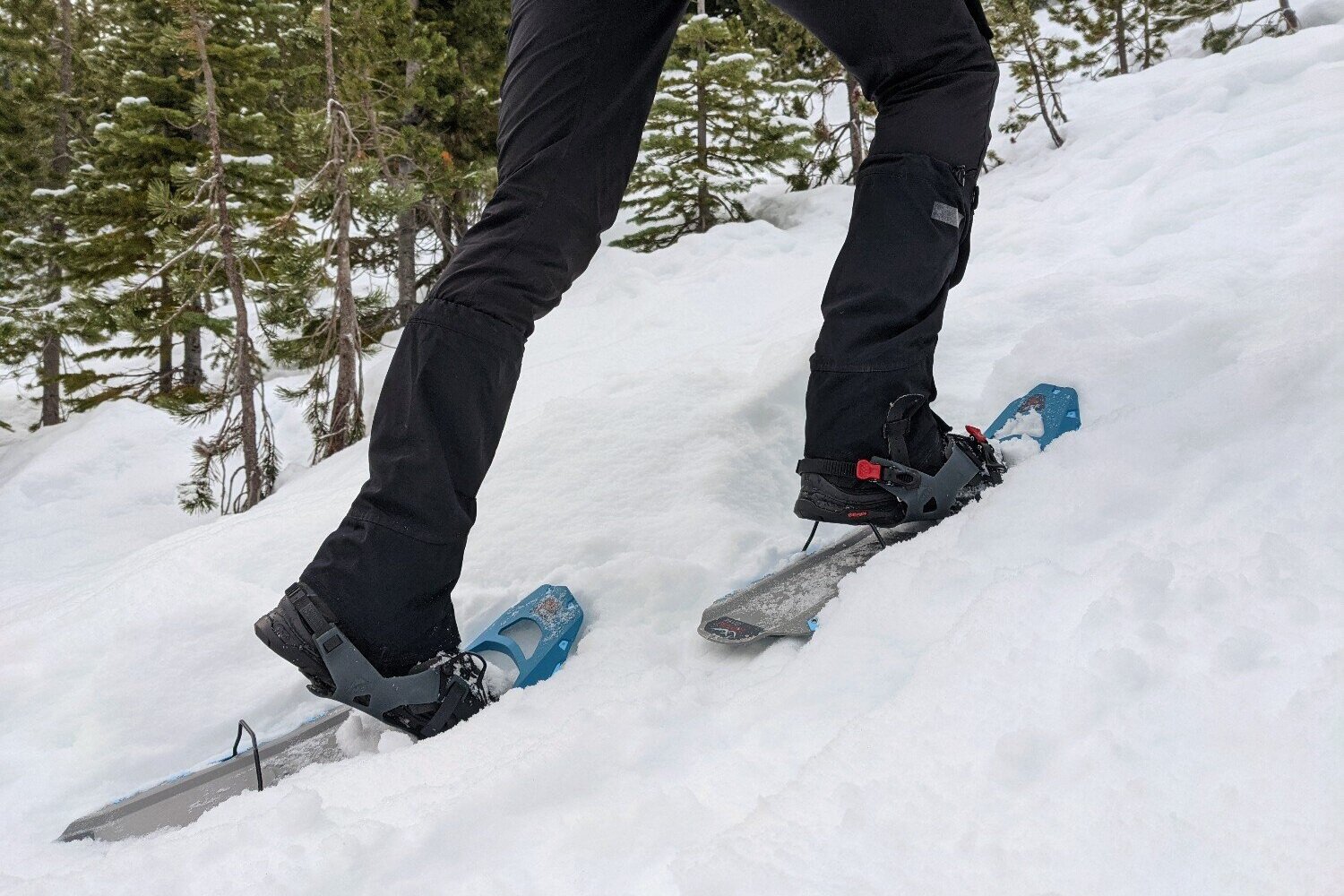
Heel lifts, like those on the MSR Revo Explore above, make traversing uphill much easier
MORE INFORMATION
We hope this guide helps you find the perfect gear for your needs. If you have more questions or a suggestion, we’d love to hear from you! Sign up for our newsletter to stay updated on our latest posts then visit our Facebook page and Instagram to join the community conversation.
If you found this guide helpful, please give it a share on social media! Also, be sure to check out our CleverHiker Gear Guide to see all of our top gear picks.
Thanks for reading and happy trails!
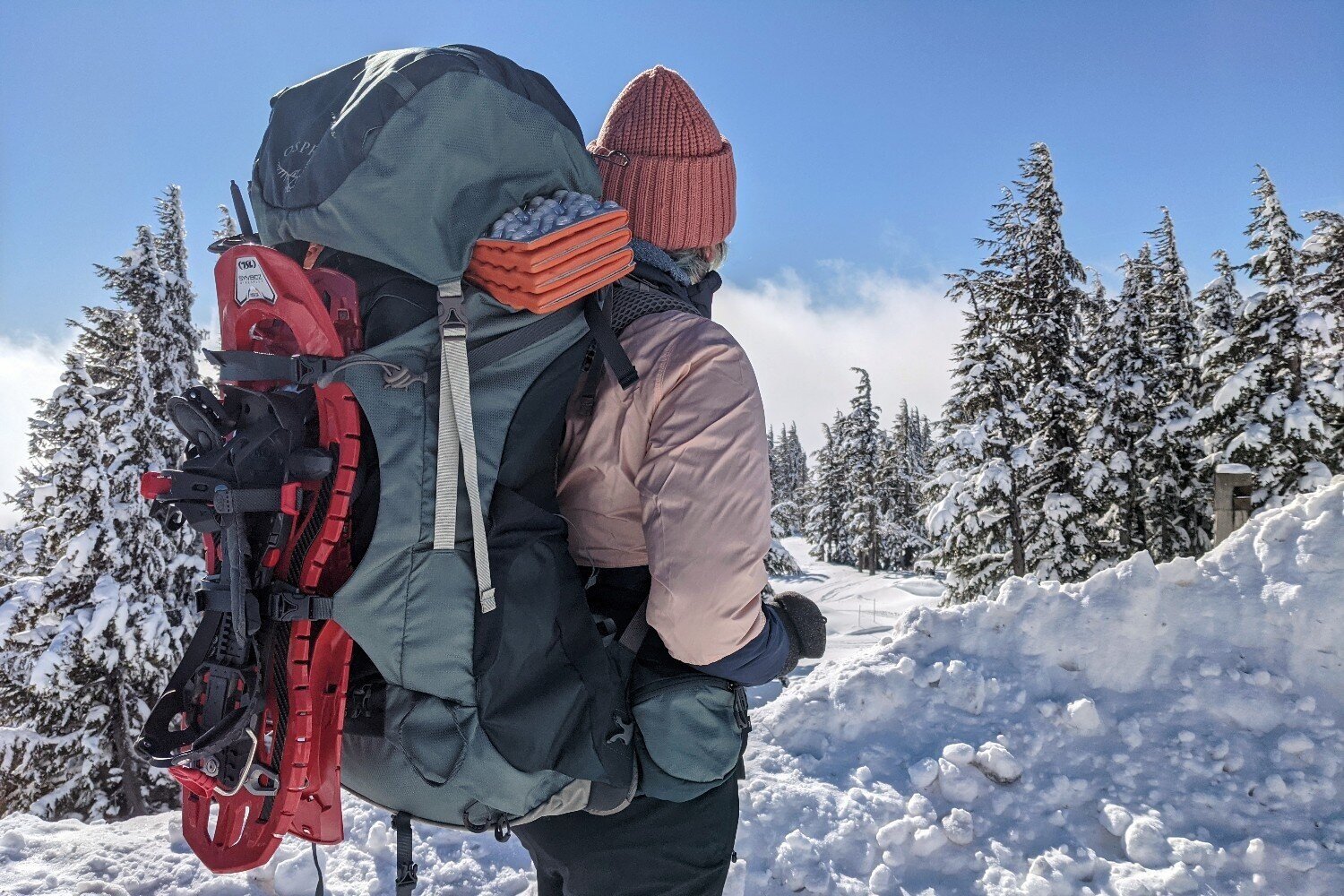
Taking the felxible and secure TSL Symbioz Hyperflex Elite out for a hike
Some of the links on this page are affiliate links, which means we may receive a modest commission if purchases are made through those links. This adds no cost to our readers and helps us keep our site up and running. Our reputation is our most important asset, which is why we only provide completely honest and unbiased recommendations.

